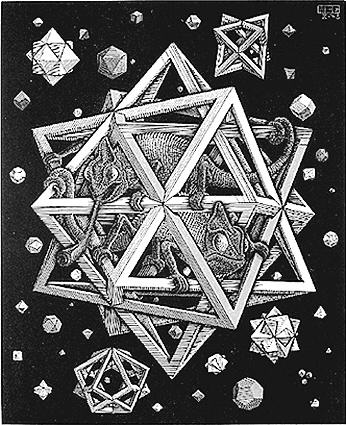Facts About Stars (M. C. Escher)
"Stars" is a captivating wood engraving by Dutch artist M.C. Escher, created in 1948. The artwork features two chameleons nestled within a complex polyhedral cage, serenely floating through space. Central to the composition is a unique structure composed of three interlocking octahedra, a concept likely devised by Escher himself.
Escher's deep fascination with geometry and astronomy is vividly expressed in "Stars." Many art critics interpret the intricate polyhedral forms as references to both astronomical and crystallographic concepts. The print showcases an assortment of polyhedra drifting through the vastness of space, with the chameleons adding a whimsical touch to the geometric precision.
Escher’s expertise in wood engraving and his penchant for incorporating polyhedral shapes into his work are particularly noteworthy. His inspirations for "Stars" stem from his profound interest in geometry and the cosmos, guidance from his wood engraving mentor, and the influence of historical luminaries like Leonardo da Vinci and Johannes Kepler.
Interpretations of "Stars" vary widely. Some see it as a reflection on astronomical themes, while others perceive elements of crystallography. The artwork's tension between order and chaos is a focal point, with Escher himself commenting on the potential instability of the chameleon-filled central cage. Related works by Escher, such as "Study for Stars" "Double Planetoid" and "Crystal" explore similar themes.
"Stars" has graced numerous collections and publications, serving as cover art for books and being displayed in major museums around the world. This piece is a testament to Escher's genius in merging mathematical precision with artistic flair, producing a visually stunning and thought-provoking masterpiece that continues to enchant audiences.

 United States
United States